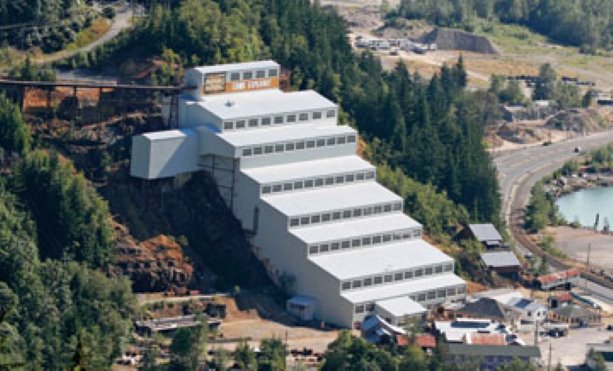Algae isn’t always a welcome sight. However, when you’re working to clean up acid mine drainage left over from the British Empire’s biggest copper mine, a little slime is an honoured guest.
Algae isn’t always a welcome sight. However, when you’re working to clean up acid mine drainage left over from the British Empire’s biggest copper mine, a little slime is an honoured guest.
When the Britannia Mine closed in the mid-1970s, adjacent Howe Sound was in rough shape.
Located on the rugged British Columbia coastline between Vancouver and Whistler, the waterway was pristine blue, yet devoid of life.
Thanks to nearly a century of mining, the landscape oozed a sickly mixture of sulphide-bearing heavy metals, mostly copper, iron, zinc and aluminum.
This leachate flowed untreated into Howe Sound, wiping out much of the sound’s delicate ecology, down to the last barnacle.
“It was like a glacial lake,” recalled Christian Madsen, B.C. operations manager for Epcor, the company the provincial government retained to co-ordinate the cleanup. “You could see down forever, but the water was clear because it was dead.”
In late 2004, following a bidding process, the B.C. government chose Epcor to design, build and operate a lime-based water treatment plant.
Construction of the $15.5-million facility started in March 2005 and was completed that October.
The Edmonton-based utility specializes in power and water treatment, but it had never cleaned up a contaminated mine site. However, it did have experience treating wastewater and using lime to soften potable water.
“We went with high-density lime sludge treatment,” Madsen said. “That was the same process we used for softening the water (in Edmonton).”
A technician monitors the treatment process.
By adding lime calcium oxide to the acidic wastewater, Epcor neutralized the acid and separated the metals from the water, essentially turning them into solids so they could sink to the bottom of storage basins within the facility.
“The heavy stuff settles, and the clear, treated water overflows from the top and goes to the outfall, out to the marine environment,” Madsen explained.
Epcor treats roughly 5,000 megalitres of contaminated water and removes close to 250,000 kilograms of heavy metals every year from the site.
Because tailings from the mine had been scattered throughout the area, Epcor built seven groundwater wells that pump contaminated water up to the treatment plant.
“We’re putting in a couple more of those wells this year,” Madsen said.
By December 2005, a year after Epcor won the contract, Howe Sound was noticeably cleaner.
Madsen said simple organisms, mainly barnacles and algae, returned to the area.
While there is no commercial fishery, there is some recreational angling.
“It was always somewhat contaminated. Now, it looks like any marine environment,” Madsen said.
With the lion’s share of the cleanup completed and the plant expected to deliver increasingly limited returns, one might anticipate an eventual closure.
However, Madsen said the acid mine drainage can’t be stopped completely so the need for treatment will likely continue in perpetuity, Epcor’s 20-year contract to run the plant notwithstanding.
The project has received outside recognition.
The Canadian Council for Public Private Partnerships acknowledged the role of multiple provincial government ministries and Epcor’s involvement.
Lockerbie & Hole was the general contractor and Stantec did engineering, while Epcor handled operations.
As well, the Prospectors and Developers Association of Canada handed the Britannia Beach Historical Society a Special Achievement Award in March for working to establish the British Columbia Museum of Mining on the site as a showcase of environmental education.
The society has maintained the museum ever since the owner at the time, Anaconda Mining, awarded it a 40-acre parcel of land close to the coastline back in 1971, shortly before the mine closed. In fact, a 20-storey mill building on museum property was designated a national historic site in 1986.
Kirstin Clausen, executive director of both the historical society and the museum, said the mill was in poor condition, but the mine site’s overall pollution precluded any serious attempt at rehabilitation.
However, Clausen explained, the clean-up changed all that.
“The award was for focusing on our mission for the last 30 years and believing that the museum could be a place to showcase environmental remediation and education.”











Recent Comments
comments for this post are closed